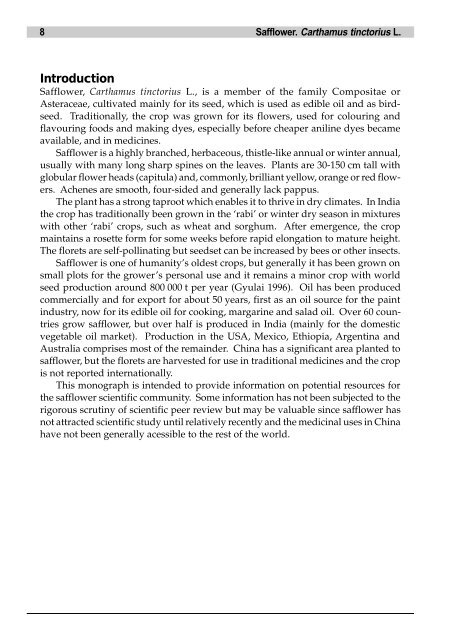Safflower, Carthamus tinctorius L. - Bioversity International
Safflower, Carthamus tinctorius L. - Bioversity International
Safflower, Carthamus tinctorius L. - Bioversity International
Create successful ePaper yourself
Turn your PDF publications into a flip-book with our unique Google optimized e-Paper software.
8 <strong>Safflower</strong>. <strong>Carthamus</strong> <strong>tinctorius</strong> L.<br />
Introduction<br />
<strong>Safflower</strong>, <strong>Carthamus</strong> <strong>tinctorius</strong> L., is a member of the family Compositae or<br />
Asteraceae, cultivated mainly for its seed, which is used as edible oil and as birdseed.<br />
Traditionally, the crop was grown for its flowers, used for colouring and<br />
flavouring foods and making dyes, especially before cheaper aniline dyes became<br />
available, and in medicines.<br />
<strong>Safflower</strong> is a highly branched, herbaceous, thistle-like annual or winter annual,<br />
usually with many long sharp spines on the leaves. Plants are 30-150 cm tall with<br />
globular flower heads (capitula) and, commonly, brilliant yellow, orange or red flowers.<br />
Achenes are smooth, four-sided and generally lack pappus.<br />
The plant has a strong taproot which enables it to thrive in dry climates. In India<br />
the crop has traditionally been grown in the ‘rabi’ or winter dry season in mixtures<br />
with other ‘rabi’ crops, such as wheat and sorghum. After emergence, the crop<br />
maintains a rosette form for some weeks before rapid elongation to mature height.<br />
The florets are self-pollinating but seedset can be increased by bees or other insects.<br />
<strong>Safflower</strong> is one of humanity’s oldest crops, but generally it has been grown on<br />
small plots for the grower’s personal use and it remains a minor crop with world<br />
seed production around 800 000 t per year (Gyulai 1996). Oil has been produced<br />
commercially and for export for about 50 years, first as an oil source for the paint<br />
industry, now for its edible oil for cooking, margarine and salad oil. Over 60 countries<br />
grow safflower, but over half is produced in India (mainly for the domestic<br />
vegetable oil market). Production in the USA, Mexico, Ethiopia, Argentina and<br />
Australia comprises most of the remainder. China has a significant area planted to<br />
safflower, but the florets are harvested for use in traditional medicines and the crop<br />
is not reported internationally.<br />
This monograph is intended to provide information on potential resources for<br />
the safflower scientific community. Some information has not been subjected to the<br />
rigorous scrutiny of scientific peer review but may be valuable since safflower has<br />
not attracted scientific study until relatively recently and the medicinal uses in China<br />
have not been generally acessible to the rest of the world.

















